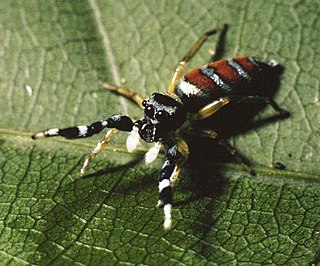
Psecas is a genus of jumping spiders that was first described by Carl Ludwig Koch in 1850.
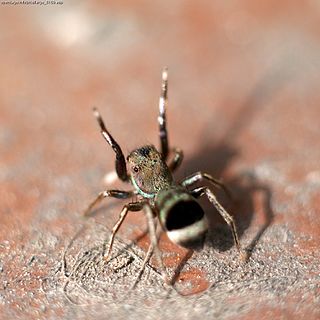
Siler is a genus of Asian jumping spiders that was first described by Eugène Louis Simon in 1889. They specialize in hunting ants.

Oonops is a genus of spiders mostly found in America, Europe to Russia and East and North Africa.

Oonops domesticus is a tiny spider from Western Europe to Russia. It is a bleak light red, with a reddish to whitish abdomen. It is found only in buildings, where it builds a retreat in corners and between old paper. It hunts at night, probably with booklice as their common prey. Its translucent flat egg sacs contain only two eggs.
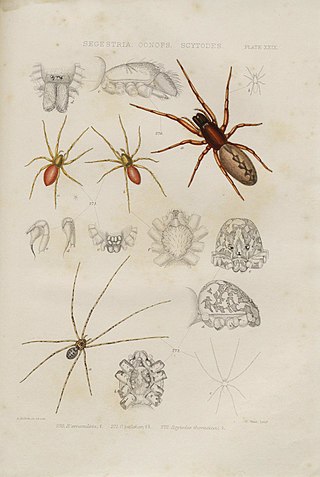
Oonops pulcher is a tiny spider. Its six eyes are located closely together, giving the impression of only one eye. The spider is of a bleak light red, with a reddish to whitish abdomen, and found out of doors in bird nests, under stones and under tree bark, also in webs of Amaurobius and Coelotes. Only two eggs are laid into a flat eggsac.

Pelvicachromis pulcher is a freshwater fish of the cichlid family, endemic to Nigeria and Cameroon. It is popular amongst aquarium hobbyists, and is most commonly sold under the name kribensis, although it has other common names, including various derivatives and color morphs of the kribensis: krib, common krib, red krib, super-red krib and rainbow krib, along with rainbow cichlid and purple cichlid.

Psalmopoeus is a genus of the family Theraphosidae containing various species of tarantulas. The genus is native to Trinidad and Tobago, Colombia, Ecuador, Venezuela, Guyana, Brazil, Belize, Panama, Nicaragua, Costa Rica, Mexico, Guatemala and Honduras. All of these tarantulas are arboreal in nature, Psalmopoeus victori being the first arboreal tarantula of Mexico.

Ariamnes is a genus of comb-footed spiders that was first described by Tamerlan Thorell in 1869. Some species have greatly elongated abdomens, making them resemble a twig.

Coenoptychus is a genus of African and Asian corinnid sac spiders first described by Eugène Simon in 1885. As of April 2019 it contains only three species, two of which were transferred from Graptartia in 2018.

Cycloctenus is a genus of Australasian araneomorph spiders in the family Cycloctenidae, first described by L. Koch in 1878. Originally placed with the nursery web spiders, it was transferred to the family Toxopidae because of the distinctive arrangement of its eyes, particularly the enlarged posterolateral eyes. It was moved to the Cycloctenidae in 1967.
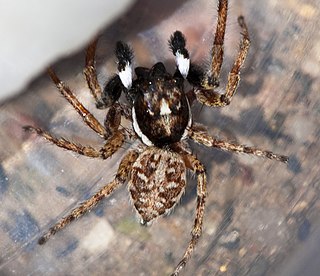
Menemerus pulcher is a species of jumping spider in the genus Menemerus that lives in Mauretania. The species was first described in 1999 by Wanda Wesołowska. The spider is small and brown, with an atypically high carapace that is 2.6 millimetres (0.10 in) long and an abdomen 2.8 millimetres (0.11 in) long. There is a white stripe running down the back of the otherwise brown carapace. The abdomen is yellowish-fawn with a dark pattern that is reminiscent of a fleur-de-lis and more rounded than other spiders in the genus. Otherwise, it is externally similar to Menemerus plenus, although it can be distinguished by its copulatory organs. The male has a double embolus and two large parallel retrolateral apophyses, or appendages. The female has not been described.
Myrmecomelix is a genus of South American dwarf spiders that was first described by Norman I. Platnick in 1993.
Thapsagus is a monotypic genus of East African sheet weavers containing the single species, Thapsagus pulcher. It was first described by Eugène Louis Simon in 1894, and has only been found on Madagascar.

Asagena is a genus of comb-footed spiders that was first described by Carl Jakob Sundevall in 1833.
Paradossenus is a genus of spiders in the family Trechaleidae. It was first described in 1903 by F. O. Pickard-Cambridge. As of 2017, it contains 13 species.
Pellenes tharinae is a jumping spider species in the genus Pellenes that lives in Namibia, South Africa and Zimbabwe. It was first described by Wanda Wesołowska in 2006. Pellenes pulcher was declared a homonym for the species in 2009.
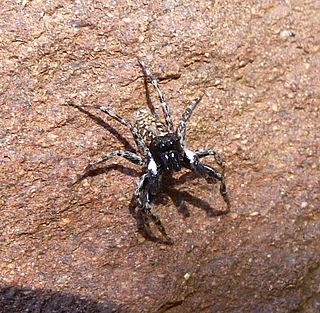
Menemerus plenus is a species of jumping spider in the genus Menemerus that lives in Yemen. The spider was first described in 1994 by Wanda Wesołowska and Anthonius van Harten. Only the female has been described. The spider is small, with a carapace that is typically 2.0 mm (0.08 in) long and an abdomen typically 3.3 mm (0.13 in) long. The carapace is brown, convex and higher than many related spiders. The abdomen is wide and rounded. It is externally similar to Menemerus pulcher and can only be reliably distinguished by comparing the internal structure of the copulatory organs. Menemerus plenus is distinctive for its lack of accessory glands and the thick wall of its insemination ducts.
Asagena pulcher is a species of cobweb spider in the family Theridiidae. It is found in the United States.

Xenoctenidae is a family of araneomorph spiders separated from Miturgidae in 2017.

Psalmopoeus pulcher, also known by its common name Panama blonde tarantula, is a species of spider from the genus Psalmopoeus.














